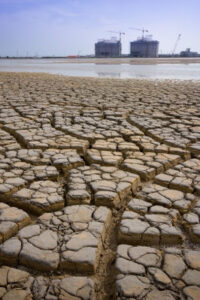
“The most important reason for optimism is that an ever-widening range of indicators suggests that the conventional wisdom—that we needed a recession to bring inflation under control—was wrong. Instead, we seem close to returning to the Federal Reserve’s inflation target without paying much of a price at all.” (emphasis mine)
Two months earlier, Krugman’s employer, the New York Times, ran a disturbing piece entitled, “America Is Using Up Its Groundwater like There’s No Tomorrow,” in which the Times chronicled how urban and agricultural interests are “draining and damaging aquifers nationwide.” The article stated:
Many of the aquifers that supply 90 percent of the nation’s water systems, and which have transformed vast stretches of America into some of the world’s most bountiful farmland, are being severely depleted. These declines are threatening irreversible harm to the American economy and society as a whole.
The New York Times conducted a months-long examination of groundwater depletion, interviewing more than 100 experts, traveling the country and creating a comprehensive database using millions of readings from monitoring sites. The investigation reveals how America’s life-giving resource is being exhausted in much of the country, and in many cases it won’t come back. Huge industrial farms and sprawling cities are draining aquifers that could take centuries or millenniums to replenish themselves if they recover at all.
At first glance, the two articles seem to have no relation to each other, but in many ways, the Federal Reserve that Krugman so lavishly praises has done to the monetary side of the US economy what our government’s water policies are doing to aquifers. In both situations, agents serving the US government are creating and expanding what is an unpayable and unmanageable debt.
In the situation regarding water, government policies have encouraged the unsustainable pumping of groundwater even though this will drain the aquifers. Likewise, federal policies have allocated more Colorado River water to agricultural groups than the river contains, so farmers are encouraged to grow water-intensive crops in areas that are near-desert in average yearly precipitation.
The Fed Depletes the Economy in Other Ways
For more than two decades, the Federal Reserve System has followed easy money policies ostensibly to allow for more so-called aggregate demand by keeping interest rates artificially low and pushing policies that have encouraged low-interest mortgages and business borrowing. According to economists like Paul Krugman, these policies have served us well (or at least have worked well because a Democrat has been in the White House), and we should not worry about high levels of federal government debt:
You can see that misunderstanding at work every time someone rails against deficits with slogans like “Stop stealing from our kids.” It sounds right, if you don’t think about it: Families who run up debts make themselves poorer, so isn’t that true when we look at overall national debt?
No, it isn’t. An indebted family owes money to other people; the world economy as a whole owes money to itself. And while it’s true that countries can borrow from other countries, America has actually been borrowing less from abroad since 2008 than it did before, and Europe is a net lender to the rest of the world.
Because debt is money we owe to ourselves, it does not directly make the economy poorer (and paying it off doesn’t make us richer). True, debt can pose a threat to financial stability—but the situation is not improved if efforts to reduce debt end up pushing the economy into deflation and depression.
To put it another way, borrowing is a shortcut to prosperity. Why save and build up capital stock when monetary authorities can just borrow at will and expand the supply of dollars that encourage more spending? After all, according to Krugman, spending is the lifeblood of an economy so anything that encourages it actually is promoting economic growth.
The Biden administration has ramped up spending even above the high levels of Donald Trump’s White House, running trillion-dollar deficits as a matter of course. Even when outfits like the Penn Wharton Budget Model warns that federal debt is hitting unsustainable levels, they are ignored. The creators of the model tell us:
Under current policy, the United States has about 20 years for corrective action after which no amount of future tax increases or spending cuts could avoid the government defaulting on its debt whether explicitly or implicitly (i.e., debt monetization producing significant inflation). Unlike technical defaults where payments are merely delayed, this default would be much larger and would reverberate across the U.S. and world economies.
Conclusion
Just as government policies have incentivized farmers and municipalities to waste their precious water resources, government borrowing and spending is draining our capital and distorting the structures of production in the economy. What we see now cannot be sustained much longer.
Unfortunately, these government policies of largess have come with no personal or political discipline. Nature, however, does not care. If farmers destroy their water resources, Congress cannot by fiat create more water supplies. Likewise, at some point as government debt levels become an unbearable burden, the Fed will be unable to pull any more rabbits from the chairman’s hat. And those of us who are living will have to bear the awful consequences.
This article originally appeared here and has been reprinted under the Creative Commons License.
Image courtesy of Jomphong at FreeDigitalPhotos.net
